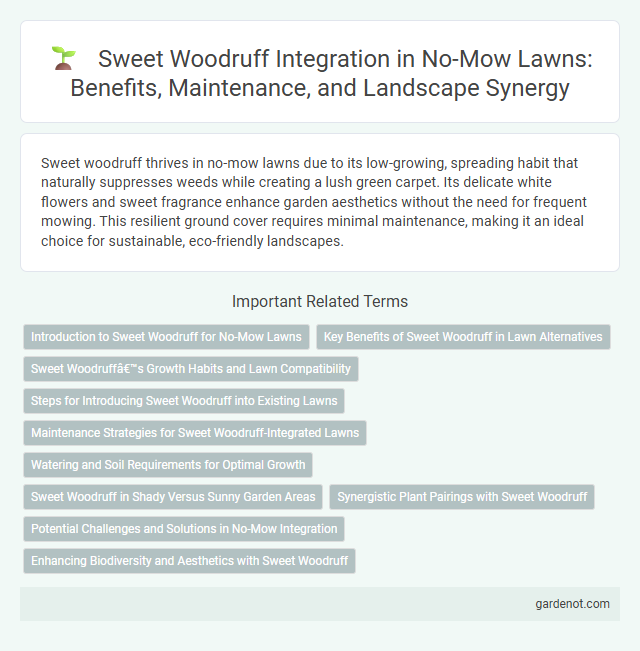Sweet woodruff thrives in no-mow lawns due to its low-growing, spreading habit that naturally suppresses weeds while creating a lush green carpet. Its delicate white flowers and sweet fragrance enhance garden aesthetics without the need for frequent mowing. This resilient ground cover requires minimal maintenance, making it an ideal choice for sustainable, eco-friendly landscapes.
Introduction to Sweet Woodruff for No-Mow Lawns
Sweet woodruff (Galium odoratum) thrives as a shade-tolerant ground cover ideal for no-mow lawns, offering low maintenance with its dense, carpet-like growth. This perennial herb produces delicate white flowers in spring and emits a sweet, hay-like fragrance, enhancing both aesthetics and sensory appeal in shaded garden areas. Its ability to suppress weeds and retain soil moisture makes sweet woodruff a sustainable choice for eco-friendly lawn alternatives.
Key Benefits of Sweet Woodruff in Lawn Alternatives
Sweet woodruff enhances no-mow lawns by providing dense ground cover that suppresses weeds and reduces soil erosion. Its fragrant foliage and delicate white flowers attract pollinators, promoting biodiversity in lawn alternatives. This low-maintenance plant thrives in shaded areas, making it ideal for eco-friendly, water-efficient landscaping.
Sweet Woodruff’s Growth Habits and Lawn Compatibility
Sweet Woodruff (Galium odoratum) thrives as a low-growing ground cover, spreading quickly through creeping rhizomes that create dense mats ideal for suppressing weeds. Its shade tolerance makes it compatible with no-mow lawns in shaded or partially shaded areas where traditional grass struggles to thrive, reducing maintenance needs. This perennial's ability to remain lush with minimal mowing or trimming enhances lawn sustainability by conserving water and reducing fertilizer use.
Steps for Introducing Sweet Woodruff into Existing Lawns
Prepare the existing lawn by mowing it short and removing debris to reduce competition. Loosen the soil surface with a rake to create a suitable seedbed for Sweet Woodruff. Sow seeds evenly in early spring or fall, then lightly press them into the soil and water regularly to encourage germination and establishment.
Maintenance Strategies for Sweet Woodruff-Integrated Lawns
Sweet woodruff thrives in no-mow lawns by requiring minimal maintenance due to its low growth habit and shade tolerance. Regular monitoring for weeds and occasional trimming to prevent overgrowth ensures a healthy, dense ground cover. Proper soil moisture management and avoiding heavy foot traffic enhance its establishment and longevity within mixed lawn landscapes.
Watering and Soil Requirements for Optimal Growth
Sweet woodruff thrives in consistently moist, well-drained soil that retains some moisture without becoming waterlogged, making regular watering essential during dry spells to maintain optimal growth. This shade-loving perennial prefers soil rich in organic matter with a slightly acidic to neutral pH, ideally between 5.5 and 7.0. Adequate watering combined with nutrient-rich, humus soil ensures lush, healthy foliage suitable for no-mow lawn alternatives.
Sweet Woodruff in Shady Versus Sunny Garden Areas
Sweet Woodruff thrives best in shady garden areas where its delicate white flowers and aromatic leaves flourish with minimal sunlight. In sunny garden spots, the plant may suffer from leaf scorch and reduced growth, making it less ideal for open, bright lawns. Its preference for moist, well-drained soil under tree canopies or shaded borders makes Sweet Woodruff an excellent ground cover solution for no-mow lawns in shady environments.
Synergistic Plant Pairings with Sweet Woodruff
Sweet woodruff (Galium odoratum) thrives alongside hostas and ferns, forming a lush, low-maintenance groundcover for no-mow lawns. Its shade tolerance and spreading habit complement these plants by suppressing weeds and enriching soil moisture retention. Pairing sweet woodruff with shade-loving perennials like astilbes enhances biodiversity and visual appeal in naturalistic garden designs.
Potential Challenges and Solutions in No-Mow Integration
Sweet woodruff (Galium odoratum) can face challenges in no-mow lawns due to its preference for shaded, moist environments and susceptibility to dryness and direct sunlight, which may inhibit its growth. To successfully integrate sweet woodruff, maintaining adequate soil moisture and providing partial shade can mitigate stress, while avoiding heavy foot traffic preserves its delicate foliage. Implementing a mulch layer and occasional watering in drought conditions support its establishment as a low-maintenance, ground-cover alternative in no-mow lawn settings.
Enhancing Biodiversity and Aesthetics with Sweet Woodruff
Sweet woodruff (Galium odoratum) enriches no-mow lawns by attracting pollinators such as bees and butterflies, thereby boosting local biodiversity. Its delicate white flowers and fragrant foliage create an appealing groundcover that enhances the lawn's visual texture without the need for mowing. This perennial's shade tolerance and low maintenance requirements make it an ideal choice for sustainable and ecologically beneficial landscaping.
Sweet woodruff Infographic

 gardenot.com
gardenot.com